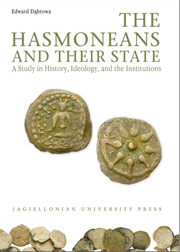Book contents
- Frontmatter
- Contents
- Introduction
- Abbreviations
- Part I Judea under the Hasmoneans (167–63 BCE)
- Part II The Institutions of the Hasmonean State
- I The Ruler
- II The State
- Part III Society
- Conclusions
- Bibliography
- Index of Personal Names
- Index of Place Names
- Index of Ancient Sources
- Electrum - Volumes Published
- The Hasmonean State
I - The Ruler
from Part II - The Institutions of the Hasmonean State
Published online by Cambridge University Press: 05 September 2014
- Frontmatter
- Contents
- Introduction
- Abbreviations
- Part I Judea under the Hasmoneans (167–63 BCE)
- Part II The Institutions of the Hasmonean State
- I The Ruler
- II The State
- Part III Society
- Conclusions
- Bibliography
- Index of Personal Names
- Index of Place Names
- Index of Ancient Sources
- Electrum - Volumes Published
- The Hasmonean State
Summary
Information provided by sources leaves no doubt that the structure of the state created by the Hasmoneans was thoroughly subordinated to the needs of their rule and purposes of their policy. In building a system of government, the Hasmoneans could draw from their neighbors' experience in this respect, and even make use for their own purposes of some elements of government established in Judea by Syrian kings. Yet an analysis of the state's structures and institutions they created suggests that the Hasmonean rulers applied solutions that were their original invention rather than copies of models existing in neighboring countries or known in a broadly understood Hellenistic world. The originality stemmed from the Jewish religious and cultural difference which largely limited possibilities of imitating foreign patterns. Even if the Hasmoneans occasionally emulated such patterns, they would transform them to such an extent as to give them an altogether different shape and content. Any attempt to describe the institutions of the Hasmonean state must be prefaced by a reservation: the effort cannot always guarantee fully satisfactory results. The main reason is the limited number of our sources, their often incidental character, and the fact that some of them have survived to our time only in fragments.
Describing and interpreting selected events outside their broader context always carries a risk of oversimplification or incomplete analysis, as well as of omission of interrelations that may exist between them.
- Type
- Chapter
- Information
- The Hasmoneans and their StateA Study in History, Ideology, and the Institutions, pp. 105Publisher: Jagiellonian University PressPrint publication year: 2009



